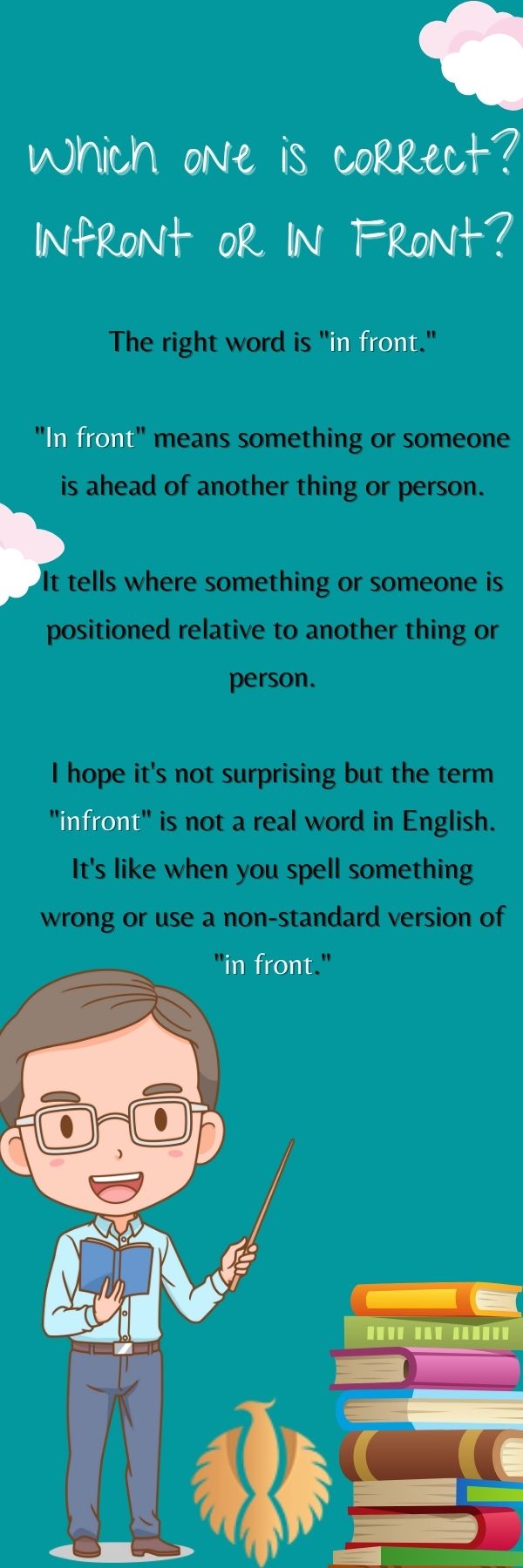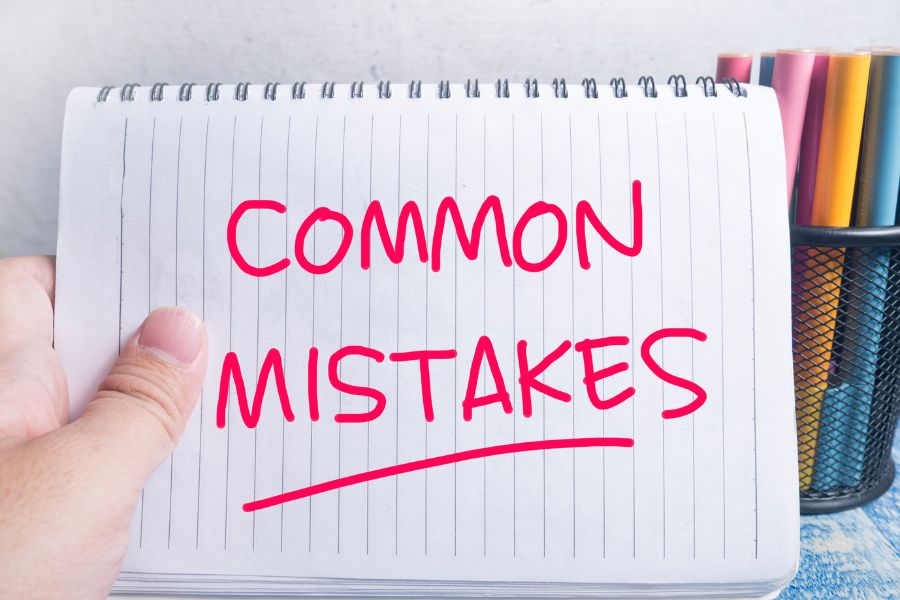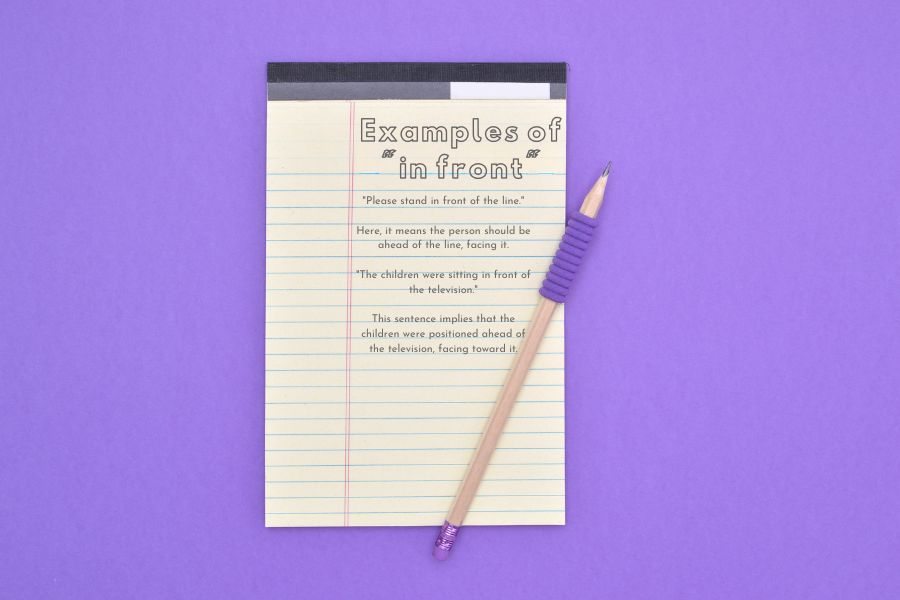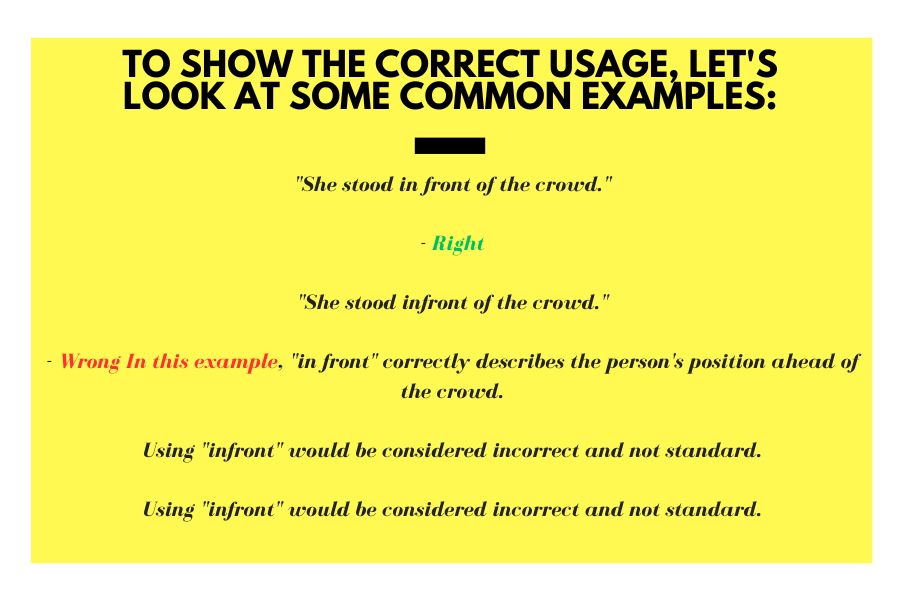Knowing how to use words right is super important for talking to people.
In this article, we’re gonna check out what “infront” or “in front” really mean and give you some examples.
By explaining what they mean and how to use them, we wanna help you get better at language and make sure you say things the right way.
Which one is correct? Infront or In Front?q

The right word is “in front.” “In front” means something or someone is ahead of another thing or person. It tells where something or someone is positioned relative to another thing or person. The term “infront” is not a real word in English. It’s like when you spell something wrong or use a non-standard version of “in front.”
You need to use the right spelling and form to communicate clearly. So let’s not forget:
- When you say “in front,” it’s best to put a space between the word “in” and the word “front.”
- In short, the right term is “in front,” which is used to talk about something or someone ahead of another thing or person.
- It’s important to spell and say it right to make sure we understand each other.
You might also enjoy: “Humans” or “Humen”? Which One Is Correct?
Common Mistakes

Because they sound alike, some people might use “infront” instead of “in front” by mistake.
But it’s super important to know that “infront” is not a real word and you should totally avoid using it in fancy writing or professional situations.
- For example:
– Wrong: The dog sat infront of the fireplace.
– Right: The dog sat in front of the fireplace.
Definition of “Infront”
The word “infront” ain’t a real word in English. It’s like a misspelling or a weird way to say “in front.”
“In front” is what we normally say, “infront” ain’t right.
“In front” means something or someone is ahead of something or someone else.
- It’s like telling you where something is compared to something else.
The word “in” means being inside a certain place.
It tells you where something or someone is inside a space.
- In “in front,” it means being inside the area that’s ahead of something or someone.
The word “front” means the very first part or side of something.
It’s the part that faces forward or towards you.
- When you put “in” in front of it, you get “in front,” which means something or someone is ahead of another thing or person.
Using “in front” right in a sentence helps make things clear and exact.
30 sentences using the word “in front”
Here are 30 sentences using the word “in front” in various contexts and situations:
1.The children eagerly waited for the bus to arrive in front of the school.
2.I parked my car in front of the grocery store, making it easy to unload the groceries.
3.The teacher asked the student to stand in front of the class to present his project.
4.There was a beautiful garden in front of my grandmother’s house, filled with blooming flowers.
5.The dog barked at a squirrel that was sitting in front of the tree.
6.I could see the tall building in front of me as I walked down the street.
7.He placed the trophy in front of his collection of medals on the shelf.
8.We laid out the picnic blanket in front of the lake and watched the ducks swim by.
9.The fireworks exploded in front of the crowd, lighting up the night sky.
10.She stood in front of the mirror, practicing her speech for the event.
11.The movie theater had a long line of people waiting in front of its entrance.
12.The statue of the founder stood proudly in front of the city hall.
13.We could see the mountains rising majestically in front of us as we drove.
14The huge banner was displayed in front of the entrance to the festival.
15.He knelt in front of her to propose, creating a beautiful moment.
16.The line for the new rollercoaster stretched in front of the amusement park.
17.A large crowd gathered in front of the stage for the concert.
18.I saw my favorite bookstore in front of me as I turned the corner.
19.The flag fluttered in front of the school during the morning assembly.
20.In front of the fireplace, we gathered to tell stories on a cold winter night.
21.I noticed the cat perched in front of the window, watching the birds outside.
22.The guide stood in front of us, explaining the history of the ancient ruins.
23.We set up our tents in front of the beautiful view of the mountains.
24.The car ahead suddenly stopped in front of me, causing me to slam on the brakes.
25.She felt butterflies in her stomach standing in front of her dream job interview.
26.A large tree provided shade in front of the playground, making it a popular spot.
27.He placed the bouquet of flowers in front of her as a surprise.
28.The old bookstore had a mysterious charm in front of its dusty shelves.
29.In front of the computer, she spent hours working on her novel.
30.We enjoyed our lunch in front of the stunning ocean view.
Sure! Here are 20 questions and answers regarding the term “in front” along with its definitions and examples. Each answer is elaborated to give context and clarity.
Examples of “in front”

- “Please stand in front of the line.”
Here, it means the person should be ahead of the line, facing it.
- “The children were sitting in front of the television.”
This sentence implies that the children were positioned ahead of the television, facing toward it.
It’s important to note that the word “infront” is not recognized by fancy dictionaries or grammar books.
You should use the right spelling and say “in front” if you want to make sure people understand you.
- To sum it up, “in front” is the right way to talk about something or someone being ahead of another thing or person. It’s a fancy way of saying that something is in the front.
“Infront” isn’t a real word and you shouldn’t use it if you want to make yourself clear. Omid Naeeimi
You might also enjoy: Boys’ or Boy’s– Which One is Correct? + Example
Things you need to know about “in front”
Most people use the right term “in front” instead of the not-standard “infront.”
It’s hard to give an exact breakdown of how often each term is used, but it’s safe to say that “in front” is the more widely accepted and commonly used phrase in English.
There are a few reasons why people prefer “in front.” First, it follows the regular rules of English grammar.
- It’s made up of the word “in” and the word “front,” with a space in between.
This makes it clear and easy to understand. Also, “in front” is what schools and language courses teach.
- It’s the version you find in dictionaries and other trusted sources.
So, people who have had formal education in English are more likely to use “in front” correctly.
- Plus, “in front” is used a lot in written materials like books and official documents.
Seeing it used correctly in these kinds of texts makes people more likely to use it themselves.
- Sometimes people might accidentally write “infront” because of a typo or because they don’t know any better.
- But it’s important to know that this isn’t the standard way to write it in English.
It’s better to use “in front” to make sure you’re communicating clearly and following the rules.
- So, in conclusion, most people use the right term “in front” instead of the not-standard “infront.”
People prefer “in front” because it follows the grammar rules, it’s taught in school, and it’s used a lot in written texts.
By using “in front,” people can make sure they’re being clear and accurate when they talk.
20 points about using Infront or In Front
- “In front” is the correct and standard way to spell the phrase referring to a position ahead of something else.
- “Infront” is considered a misspelling or non-standard variation of “in front.”
- Using “in front” maintains consistency with established spelling norms in English.
- The phrase “in front” is commonly used to describe the position of an object relative to another object.
- It is important to use the correct spelling, “in front,” to ensure clear and effective communication.
- The spelling “infront” may be flagged as an error by spell-checking software.
- “In front” is used to indicate a location that is ahead or before something else in space or time.
- Consistent use of proper spelling, such as “in front,” reflects attention to detail in writing.
- In professional or academic writing, accuracy in spelling, including using “in front,” is crucial for conveying credibility.
- The phrase “in front” is often used in directions, instructions, descriptions, and narratives to indicate positioning.
- Using “in front” instead of “infront” helps maintain the clarity and professionalism of written content.
- When proofreading written work, checking for correct spellings like “in front” ensures language precision.
- Proper spelling, such as “in front,” contributes to enhanced readability and comprehension in written communication.
- Consistent use of standard spelling conventions, including “in front,” promotes effective language usage.
- Correct usage of “in front” demonstrates adherence to language rules and conventions in writing.
- “In front” is a commonly used prepositional phrase denoting spatial relationships in English.
- Writers should be mindful of selecting the appropriate spelling, “in front,” to avoid confusion or misinterpretation.
- Revising drafts to ensure the correct spelling of phrases like “in front” enhances the overall quality of writing.
- Understanding the distinction between “in front” and “infront” can help writers improve their language precision.
- When in doubt about spelling, consulting a dictionary or style guide is recommended to confirm the correct usage of “in front” in writing.
Definition of “In Front”

The term “in front” is like a fancy way of saying something is ahead of something else.
People use it a lot in English to explain where something or someone is.
It’s super important to understand what “in front” means if you want to communicate clearly.
- Basically, “in front” is made up of two parts: the word “in” and the word “front.”
“In” is all about being in a certain place, and “front” means the forward-facing side or direction.
So when you put them together, “in front” means something is ahead or before something else.
- The whole idea of “in front” can be used in all sorts of situations.
Like, it can describe how things or people are placed in relation to each other.
- If you’re waiting in a line, the person in front of you is, well, “in front” of you.
And if you’re driving on a road, the car in front of you is “in front” of your own car.
Besides just where things are, “in front” can also mean when someone is leading or taking charge.
- For example, in a team project, the person who’s making decisions and leading can be called “in front” of the group.
It’s like super important to know that “in front” is usually used to talk about something that’s right ahead or right before.
It’s like saying it’s super close.
- If something or someone is like further ahead or far away, you can use other phrases like “ahead of” or “before”.
How you use “in front” can be different depending on the situation and how you say it.
You can use it with verbs, adjectives, and other words to give more info about where things are or how they’re related.
You might also enjoy: Thanks God or Thank God – Fully Explained + Video
Example of how “in front” can be used in sentences

- “The cat is sitting right in front of the fireplace.”
– This sentence describes where the cat is, which is right ahead or before the fireplace
The term “in front” basically means that something is ahead or before something else.
- It’s used to describe where things or people are in relation to each other, and it can also be used to show that something or someone is in a leading or important position.
- It’s super important to know what “in front” means and how to use it when you’re trying to communicate effectively.
Proper Usage of “in front”
The way you use “in front” and “infront” is super important for clear and effective talking.
- “In front” is the right way to say it and everyone agrees, but “infront” is like a fancy way or a mistake.
Knowing how to use these words right can help you avoid getting mixed up and make sure you’re sayin’ things accurately.
- “In front” is like this fancy way of sayin’ that something or someone is ahead of somethin’ or someone else.
It’s like sayin’ where somethin’ or someone is compared to somethin’ else.
It’s made up of the words “in” and “front” and it’s all about bein’ ahead of somethin’.
Check this example:
“The kids were sitting right in front of the TV.”
In this example, “in front” is used to show where something or someone is compared to something else.
It tells us how things are positioned.
But, you know what? “Infront” isn’t even a real word in English.
It’s just a misspelling or a weird way of saying “in front.”
You might hear it in casual talks, but it’s not cool to use it in formal writing or professional situations.
- Using “infront” instead of “in front” can cause confusion or misunderstandings.
It’s important to follow the standard rules of English grammar and usage to make sure we communicate effectively.
You might also enjoy: Trainer or Trainor: 10 Main Differences + Examples [2023]
To show the correct usage, let’s look at some common examples:

- “She stood in front of the crowd.”
– Right
- “She stood infront of the crowd.”
– Wrong In this example, “in front” correctly describes the person’s position ahead of the crowd.
Using “infront” would be considered incorrect and not standard.
Using “infront” would be considered incorrect and not standard.
- It’s important to mention that the difference between “in front” and “infront” isn’t just about these specific phrases.
It’s actually a bigger deal about sticking to proper grammar and usage when you’re writing or talking all fancy.
- So, to sum it up, the right way to say it is “in front.”
That’s a fancy way of saying something or someone is ahead of another thing or person.
- “Infront” is like a fancy way of saying it wrong or not knowing how to spell it.
So, if you’re trying to be all formal and professional, stay away from “infront.”
Using the right way just makes everything clear and accurate when you’re communicating.
For example, all the kids lined up in front of the school for the class picture.
Conclusion
To sum up, knowing the difference between “infront” and “in front” is hella important for talking right.
“In front” is the right and common way to say it, while “infront” is just a fancy way of misspelling.
If you use the right words, you can level up your language game and get your point across like a boss.
Q&A about “In Front”
- **Q: What is the primary definition of “in front”?**
**A:** “In front” primarily refers to the position that is situated ahead of something else, either in a physical sense or in a figurative context. It indicates a location that can be seen as facing towards the observer or a particular reference point. For example, “The large tree stands in front of the house,” emphasizes that the tree is positioned ahead of the house when viewed from a certain angle.
- **Q: Can “in front” be used in a social context?**
**A:** Yes, “in front” can be used in a social context to describe scenarios where someone is positioned before others in a gathering or event. For instance, “She stood in front of the audience to give her speech,” indicates her position at the forefront, where she is the focus of attention.
- **Q: How does “in front” relate to spatial awareness?**
**A:** “In front” enhances spatial awareness by helping to describe locations relative to one another. For example, “The bus stop is in front of the library,” aids individuals in navigating their environment by giving them clear directional information regarding where to find the bus stop relative to the library.
- **Q: What is an example of using “in front” in a figurative sense?**
**A:** Figuratively, “in front” can describe prioritizing or leading a group in ideas or actions. For instance, “He placed his ideas in front of the committee,” indicates that he presented his concepts before others, aiming for them to be considered first.
- **Q: Is “in front” applicable in descriptions of movement?**
**A:** Yes, “in front” can describe the movement of people or objects. For example, “The dog ran in front of the children as they walked to the park,” shows the dog leading the way, highlighting its position while moving.
- **Q: Can “in front” be used to indicate a timeline or sequence?**
**A:** While primarily spatial, “in front” can suggest priority in a sequence. For instance, “In front of all other tasks, prioritizing health is essential,” emphasizes the importance of health over other considerations.
- **Q: How can “in front” be utilized in a competitive context?**
**A:** In competitive scenarios, “in front” can denote leading positions. For example, “The athlete was in front of the pack during the marathon,” indicates that the athlete was ahead of the other competitors, suggesting proficiency and skill.
- **Q: What does it mean when something is “right in front” of someone?**
**A:** The phrase “right in front” intensifies the idea of proximity, suggesting something is located directly ahead and easily observable. For example, “The sign is right in front of the entrance,” illustrates that the sign is positioned so that it cannot be missed by anyone entering.
- **Q: How do you use “in front” with motion descriptors?**
**A:** “In front” can be paired with motion descriptors to clarify directionality. For instance, “He walked in front of her,” indicates his movement ahead of her, creating a clear picture of their relative positions.
- **Q: Can “in front” describe a physical object blocking another?**
**A:** Yes, “in front” can describe a situation where one object obscures another. For example, “The tall building is in front of the sunset,” conveys that the building obstructs the view of the sunset, affecting the visibility of the natural scene.
- **Q: How does “in front” function in academic or professional settings?**
**A:** In academic or professional discussions, “in front” may refer to presenting ideas or findings. For example, “The researcher presented her findings in front of the scientific panel,” suggests she stood before the panelists to share her work.
- **Q: Can “in front” also imply a leadership role?**
**A:** Yes, “in front” can imply leadership or initiative. For example, “He took the initiative to lead the project in front of his colleagues,” indicates that he positioned himself as the leader or spearhead of the project’s efforts.
- **Q: What is the difference between “in front of” and just “front”?**
**A:** “In front of” is a prepositional phrase indicating position relative to something else, while “front” itself often refers to the forward-facing part of an object or area. For example, “The front of the car was damaged,” focuses on a specific area, whereas “The car is parked in front of the house” indicates location.
- **Q: How can “in front” relate to technology or devices?**
**A:** “In front” can describe the arrangement of devices or screens. For example, “The monitor stands in front of the keyboard,” delineates the spatial relationship between these two pieces of equipment in a workspace setup.
- **Q: What does it convey when someone is waiting “in front” of a location?**
**A:** When someone is waiting “in front” of a location, it suggests they are positioned at the entrance or visible area. For example, “She waited in front of the café for her friend,” highlights her expectation in a specific, noticeable spot.
- **Q: Can children be taught to use “in front” in their vocabulary?**
**A:** Yes, children can learn to use “in front” to articulate spatial relationships. For instance, by saying, “The cat is in front of the TV,” they can express observations of their surroundings more effectively.
- **Q: How does “in front” differ in various cultures?**
**A:** The concept of “in front” can differ culturally, especially in contexts like queueing or social interactions. For example, “In some cultures, it is polite to stand in front of someone when speaking,” indicating respect or attentiveness.
- **Q: What role does “in front” play in public speaking?**
**A:** In public speaking, “in front” is crucial as speakers often stand in front of their audience to convey messages. For example, “The speaker positioned himself in front of the audience to engage them directly,” focuses on the dynamic of connection during a presentation.
- **Q: What does “in front” imply about visibility?**
**A:** “In front” often suggests visibility and focus, indicating that the subject is prominently displayed. For example, “The painting hung in front of the fireplace, drawing everyone’s attention,” indicates its prominent position within the room.
- **Q: How can “in front” be used in a narrative context?**
**A:** In narratives, “in front” creates vivid imagery and position dynamics. For example, “As she walked through the door, she found a surprise party in front of her,” uses the phrase to build suspense and excitement regarding what is being revealed.
Frequently Asked Questions
1. What is the difference between “Infront” and “In Front”?
“In Front” is the correct spelling and standard usage to indicate something located ahead of or before another object, while “Infront” is considered a misspelling or non-standard variation.
2. How can “In Front” be defined?
“In Front” refers to a position or location situated ahead of something else in terms of space or time.
3. Can you give an example of when to use “In Front” in a sentence?
Certainly! An example would be: “The car parked in front of the house.”
- What is the significance of using “In Front” in written communication?
Using the correct spelling, “In Front,” ensures clarity and accuracy in conveying spatial relationships in writing.
4. When might one mistakenly use “Infront” instead of “In Front”?
“Infront” is commonly used as a typographical error or due to lack of awareness of the correct spelling of “In Front.”

Hi, welcome to my blog! My name is Omid and I am thrilled to have you here! I am an English language teacher with 12 years of experience and hold multiple international certifications (TESOL, IELTS, TOEFL, PTE, CELTA). Additionally, I hold a PhD in Applied Linguistics with a specialization in Teaching English as a Second Language (TESL), which fuels my passion for teaching English and assisting others in mastering the language. To me, nothing is more rewarding than helping individuals enhance their English language abilities through various methods. So, let’s embark on this journey of learning English together.




